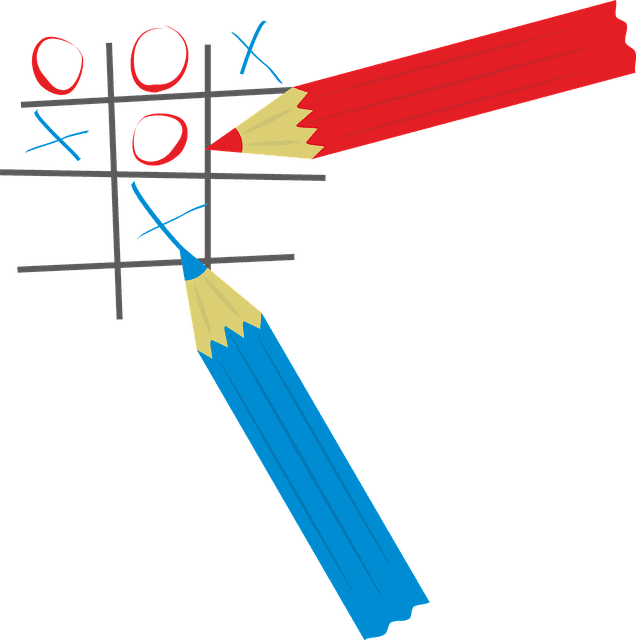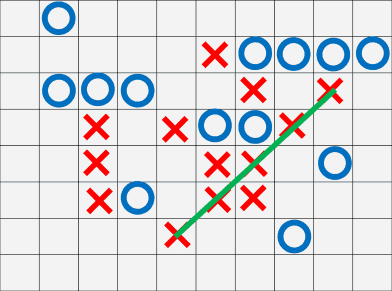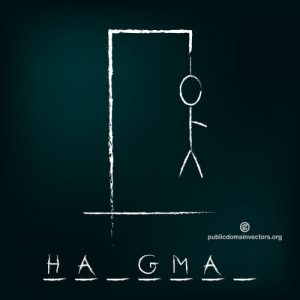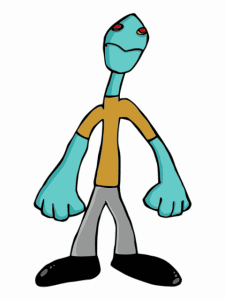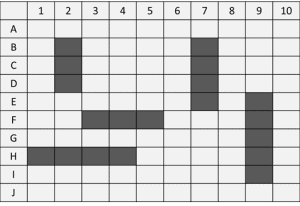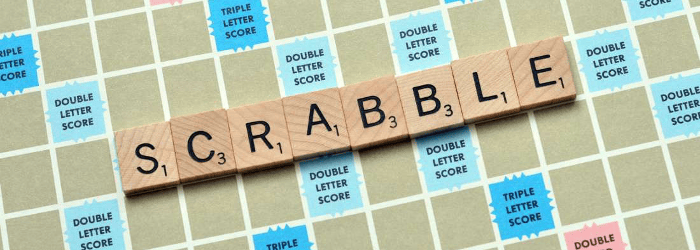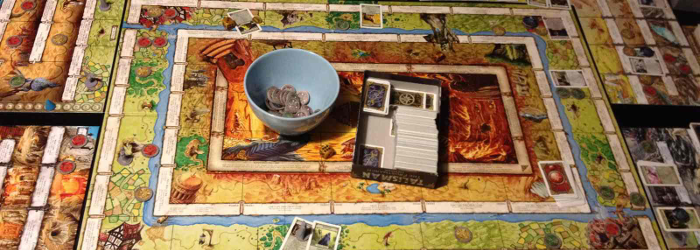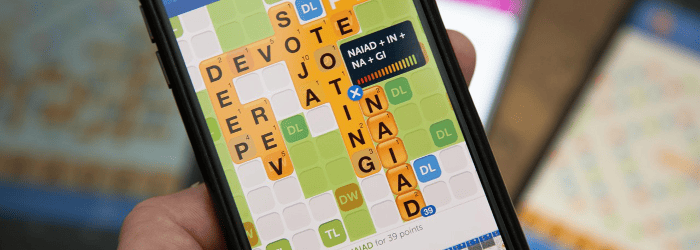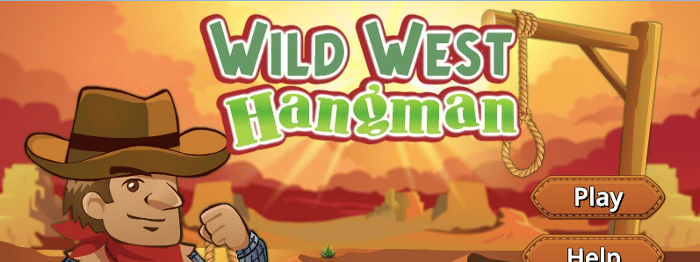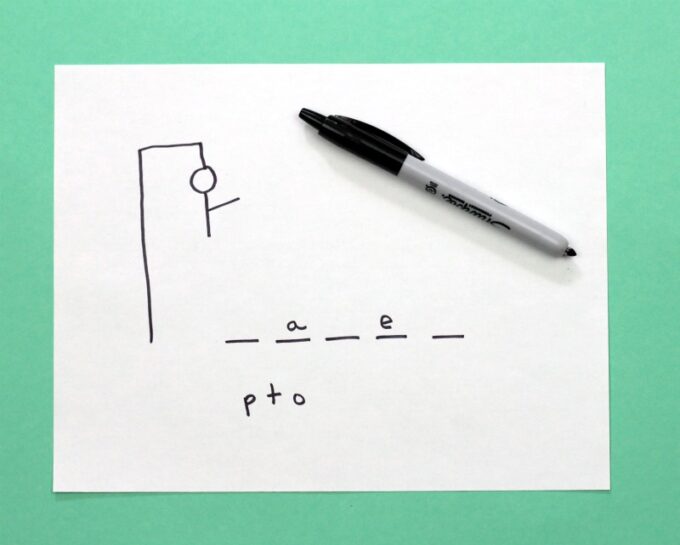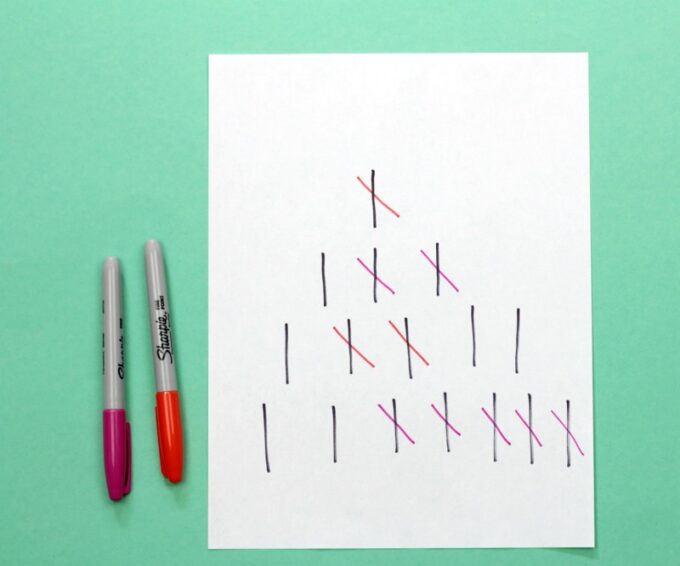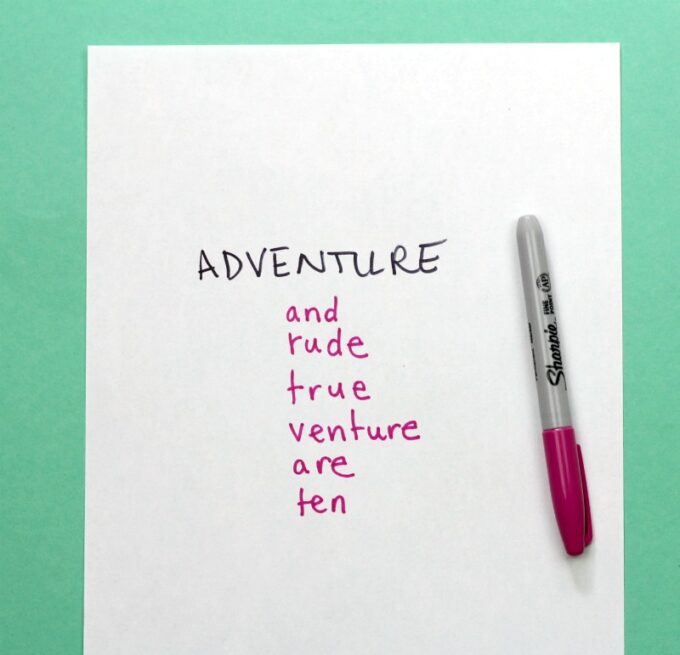Everyone likes to play games, and pen and paper games are a quick and easy way to pass the time. Our selection includes games for one, for two, and for groups. We have games easy enough for small children and challenging enough for adults. Our selection includes old favorites and some you have probably not heard of before. Carry a pen or pencil, and a tablet or a few sheets of paper in your pocket or purse, and you are ready to play these games anywhere.
Table of Contents
- 1 Pen and Paper Games for Adults
- 1.1 Categories Pen and Paper Game
- 1.2 Pen and Paper Pictionary
- 1.3 Bulls and Cows Pen and Paper Game
- 2 Pen and Paper Games for One
- 2.1 Word Watch Pen and Paper Games
- 2.2 Close Your Eyes Drawing Game
- 2.3 Category Doodling Pen and Paper Game
- 3 Pen-or-Pencil Paper Games for Multiple Players
- 3.1 Word Square Pen and Paper Game
- 3.2 Pen and Paper Telephone
- 4 Pen and Paper Games for Two Players
- 4.1 Tic-Tac-Toe
- 4.2 Sim Pen and Paper Game
- 4.3 Dots and Boxes Pen and Paper Game
- 4.4 Sprouts Pen and Paper Game
- 4.5 Battleship
- 4.6 Hangman Pen and Paper Game
- 4.7 Connect Four Pen and Paper Game
- 4.8 SOS Pen and Paper Game
- 4.9 Related Posts
Often, we need a quick way to fill time. A party bogs down, we are caught waiting at a restaurant or airport, or we simply want something quick and easy to help us pass the time. All one needs is a pen and some paper for the following easy games to challenge the thinking and create some fun. The following games are challenging enough for adults, but older children will enjoy them as well.
Categories Pen and Paper Game
Simply choose five to ten categories and write them at the top of a paper. Each player takes turns picking a letter of the alphabet. Then all of the players take turns listing something in each category starting with that letter. The players each have one minute for their turn. Each round, the points are totaled. A player only gets points for words that are uniquely theirs. After all of the categories are finished, the player with the most points wins the game. Try the following categories or choose your own:
- Fruits
- Vegetables
- Movies
- TV Shows
- Pets
- Things That Whistle
Pen and Paper Pictionary
Any number of people can play this game. Give each person a piece of paper and a pen or pencil. Instruct them to write down a common phrase and fold the paper up. Collect all of the papers and place them in a box or basket. Players take turns choosing a paper and either act out the phrase or draw it on a large piece of paper. (Newsprint works well). The person who guesses correctly draws or acts out the next phrase. If you wish, you can provide a category for the game, such as one of the following:
- Book titles
- Movie names
- Sports teams
- Famous places
Bulls and Cows Pen and Paper Game
Put on your thinking cap for this one! Each player creates a secret numeric sequence of four numbers. Players take turns guessing the number with “Bulls” indicating the correct number of digits in the correct place and “Cows” indicating correct numbers in the wrong position for each guess. The goal is to discover secret sequence in the least number of turns.
Pen and Paper Games for One
Sometimes one sits alone and wishes to look busy. Or maybe one is bored or trying to pass time while waiting for a friend, phone call, or appointment. Solitary pen and paper games are difficult to find. We have original pen and paper games for one person you will find easy and fun.
Word Watch Pen and Paper Games
Wherever you are sitting, jot down as many words as you can see easily from your surroundings.
- Game 1: Form sentences or even a short story from the words you find.
- Game 2: Put the words you find in alphabetical order.
- Game 3: See how many smaller words you can make from larger words.
- Game 4: See if you can find a word for every letter in the alphabet.
Close Your Eyes Drawing Game
Close your eyes and draw a picture. Choose something simple, such as a house, tree, or stick figure person. Those watching may think you are praying, meditating, or in deep concentration. All the while you are attempting to draw a familiar object from memory without looking at the paper.
Category Doodling Pen and Paper Game
Choose a category of something that is simple to draw and see how many variations you can create. Examples are leaves, decorated balls or boxes, circles with designs, hearts, flowers, or drink glasses.
Pen-or-Pencil Paper Games for Multiple Players
Even though we live in a technological world, there are times when one can use a pen and pencil game to have fun in a group. The following two games work well at parties and as icebreakers in classrooms and offices. Although they are challenging, older children will enjoy them also.
Word Square Pen and Paper Game
Two or more players will enjoy this simple yet challenging game. Each player begins by drawing a four space by four space square on a piece of paper and hiding it from the other player(s). The players take turns calling out a letter. As each letter is called out, players must write the letter somewhere on their grid. The goal is to make as many four-letter words as possible. Called out letters may be repeated. When all of the grids are full, players disclose their grids and count how many four-letter words they were able to create vertically, horizontally, and diagonally. The player with the most wins the game.
Pen and Paper Telephone
You will need three or more people to play this pen and paper game also known as “Gossip!” Begin with a standard 8 ½ x 11-inch sheet of paper for each player. Everyone draws a picture at the top of the paper and passes the paper to their left. Then each player captions the picture and folds it so only the sentence shows. The papers are passed again and the next player draws a picture to fit the sentence. This continues until the paper is full. The papers are unfolded to see a funny story. If you wish, you may begin by folding the papers into four or more sections – one for each player.
Pen and Paper Games for Two Players
Pen and paper games are perfect for two players and there are many two-player games out there. Very young children begin with Tic-Tac-Toe and move to more challenging games. Students become secretive proficient players when bored in class. Some of the following games provide a challenge to even the most sophisticated players.
Tic-Tac-Toe
Probably the first and easiest pen and paper game learned by a child is Tic-Tac-Toe. Grids of two vertical and two horizontal lines are filled with either an X or O as players take turns. The goal is to have three marks in a row – horizontally, vertically, or diagonally – before your opponent. The player who goes first can have the advantage. Two experienced players often end the game in a draw. Tic-Tac-Toe teaches good sportsmanship and beginning reasoning to young children.
Sim Pen and Paper Game
You need two different colors to play this two-player game, but we have included it here as it is so much fun. Draw six dots in a hexagon (a six-sided geometric shape). Take turns drawing lines between each dot. You can either use two different colored pens or a pen and a pencil. The object is to avoid making a triangle. The first person whose line completes a triangle loses this game.
Dots and Boxes Pen and Paper Game
Begin with a grid of dots drawn on a piece of paper. You can choose what size grid you wish to use. A six-by-six grid works well for younger children. More advanced players may wish to draw a much larger grid. Two or more players take turns with different colored pens or pencils drawing lines between dots. The goal is to complete a box while preventing the other player from doing so. When a block is completed by a player, they write their initials inside and draw another line. When all of the dots are connected, the person with the most completed blocks wins.
Sprouts Pen and Paper Game
Another connect-the-dot game, Sprouts is challenging and fun. Two players take turns drawing curved lines to connect dots until one of the players is unable to do so. Begin with two or more dots drawn on a piece of paper. Take turns drawing lines to connect dots with the following directions and rules:
- A line must not pass through another spot or cross another line.
- Lines may be drawn joining two spots or a single spot to itself.
- No more than three lines can emerge from any spot.
- When a player draws a line, they draw a spot on the new line.
The last player able to draw a line wins the game.
Battleship
You may know this as a boxed strategy game, but it is easily played with pen and paper. Players begin by drawing two grids with ten vertical and ten horizontal lines on two separate sheets of paper. The horizontal side is lettered and the vertical side numbered. On one sheet, each player draws rectangles representing a fleet of ships without letting the other player see their location. On the other grid, hits are marked with an X and misses with an O. The ships must take adjacent squares vertically, horizontally, or diagonally. Each player’s fleet consists of the following:
- 1 aircraft carrier covering five squares
- 1 battleship covering four squares
- 1 cruiser covering three squares
- 2 destroyers covering two squares each
- 2 submarines covering one square each
Players take turns firing a salvo of seven shots, calling out guessed locations of the other player’s ships, example F6, G9, etc. An opponent must state the number of hits and the type of ship, but not which shots were hits and which misses. Once all the squares of a ship are discovered, a player must say, “You sank my battleship (cruiser, destroyer, etc.).” Each time a player loses a ship, the salvo is reduced by one shot. The goal is to sink all of an opponent’s ships to win the game.
Variations:
- The grid can be made smaller.
- Players can have fewer ships.
- Only one shot is allowed each turn.
If you wish, you can play with the optional rule that no two ships can touch.
Hangman Pen and Paper Game
An expert player of this simple word pen and paper game knows how to stump their opponent with repeated letter words and short words. One player draws gallows with an empty rope and blanks for each letter of a word below it, leaving space to complete the drawing of a hanged man. The other player guesses each missing letter of the word with each incorrect guess resulting in another part of the hanging man’s body – head, torso, two arms and two legs. If the player guesses the word before the hangman is completed, they win. If not, the player who chose the word wins.
Connect Four Pen and Paper Game
No need for a store-bought version of this fun game. Simply draw ten lines horizontally and vertically to create twenty squares. Then take turns drawing circles in an attempt to get four in a row. Once the bottom row is filled, players must “drop” their circles on top of another. Players can either mark the circles with their initials or use X and O. The first to get four in a row wins.
SOS Pen and Paper Game
SOS is played on a grid of squares of any size, usually 3 x 3. Two players attempt to label sequential squares either vertically, horizontally, or diagonally with SOS. Once a player succeeds, they take another turn and continue until they cannot create any more. Players may play either an S or an O on their turn. To differentiate between players, one player circles their letters, and the other places a line through theirs. (They can also use different colored pens.) If neither player gets a SOS, the game is a draw.
Pencil-or-pen and paper games provide a quick and easy solution to the complaint, “I’m bored!” These games can be played anytime and anywhere. So, grab a pen or pencil and challenge a friend, introduce a group game at your next party, or teach you child strategic thinking with our collection of fun games.
Susan majored in English with a double minor in Humanities and Business at Arizona State University and earned a Master’s degree in Educational Administration from Liberty University. She taught grades four through twelve in both public and private schools. Subjects included English, U.S. and world history and geography, math, earth and physical science, Bible, information technologies, and creative writing.
Susan has been freelance writing for over ten years, during which time she has written and edited books, newspaper articles, biographies, book reviews, guidelines, neighborhood descriptions for realtors, Power Point presentations, resumes, and numerous other projects.
Read full bio
Paper and pencil games can be incredibly fun for kids, teenagers and adults alike. Playing word games on paper is simple and a fantastic way to pass the time or practice vocabulary.
As a teacher, there are always those times in class when you have extra time to fill. Simple paper games are perfect as a time filler and they require no prep.
That’s why we have put together this list of our top five pencil and paper games / word games on paper. All you need for these activities are, you guessed it, a pencil and paper.
1. Connect 5
This simple paper and pencil game is very easy to set up and is best played in pairs. Simply ask students to draw a large grid on the paper with many squares, or make a simple grid on your computer and print it out.
To play, one student will be ‘X’ and one student will be ‘O’. The students should take turns choosing a square and marking their shape. The aim of the game is to connect five shapes in a vertical, horizontal, or diagonal row.
To adapt this game for the classroom, you can ask students to first write the lessons key vocabulary / sentences in the squares before starting the game. And then, as they choose a square they should make a sentence / dialogue using the information in that box.
2. Hangman
This classic paper and pencil game is great for reviewing vocabulary and spelling, and a fun time-filler activity.
To, play one student should think of a word and write a small horizontal line for each of the letters of that word. Then their partner should try to guess what the word is by guessing letters of the alphabet.
If he/she guesses correctly, then the student should write that letter on the corresponding blank line. If he/she guesses wrong, then the students should begin to draw the ‘hangman’ picture. This is a simple stick figure drawing of a man hanging. Guess wrong too many times, and the drawing will be completed and the game is lost.
If you are teaching kids you may, like me, think this drawing is not appropriate. A great alternative is to ask students to draw a sad face, or some other simple shape. Another great alternative to traditional hangman is Games4esl’s ‘Save The Teacher Game’.
3. Draw A Monster
In this incredibly fun pencil and paper game students will work together to draw many funny monster pictures.
To play, first give each student a blank piece of paper and tell them to fold it into 3 equal sections. Then on the top section, tell students to draw the head of the monster. They can draw this in anyway they want.
Next, students should fold over the paper so they cannot see the drawing of the monster head, and then pass their paper along to the student to their left. Now, all students should have a different piece of paper.
Then, ask students to draw the body and arms of the monster, without looking at the ‘head’ drawing. Then again, students should pass the paper along to the next student, and they should then draw the legs of the monster.
At the end of this pencil and paper game, collect the drawings and then reveal the funny monster pictures to the class. This activity is great for reviewing body parts vocabulary and descriptions.
4. Battleships
You may be surprised that this popular board game started out as a simple pencil and paper game for two. This game is best played in pairs.
To play, give students a piece of paper and ask them to draw out an 11×11 grid. Then tell them to mark the numbers 1-10 across the top row, and A-J down the side. These will be used to call out the coordinates when guessing where their partner’s battleships are. Alternatively, you can ask students to write key vocabulary from the lesson in place of the alphabet and numbers.
Next, each student needs to draw their ‘battleships’ wherever they want on the grid. They must draw one ‘carrier’ consisting of 5 squares, 2 ‘battleships’ consisting of 4 squares each, and 3 ‘destroyers’ consisting of 3 squares each.
Once students have drawn their battleships, the game can begin. Students should take turns calling out coordinates as they try to find their partner’s battleships. The first student to find and ‘sink’ all their partner’s battleships is the winner.
5. Tic Tac Toe
The last paper and pencil game on our list is Tic Tac Toe. This incredibly easy and simple game is best played in pairs.
To play, ask students to draw a 3×3 grid on a piece of paper. Then students will take turns drawing their shape (usually O or X) in one of boxes. The aim of the game is to get three of your shapes in a horizontal, vertical, or diagonal line.
To make this game more language focused, you can ask students to write key words from the lesson in the boxes before starting the game. Then, when a student chooses a square, he or she must make a sentence using the word in the box.
Other Pencil and Paper Word Games
The ladder game is another fun game that you can play with just a pen / pencil and paper.
Check the above video for instructions on how to play. For more paper games, including board games, check out our printable board games page where you can download over 100 printable word games for free on many topics.
Thanks for reading.
If you want to improve your writing, maybe it’s time to ditch all the writing books and podcasts and play some word games instead.
Yes, seriously! Word games and writing games are great ways to develop your vocabulary, to help you think more deeply about words, to have fun with story and structure, and to get a lot of fun out of writing.
But games can be a great way to:
- Develop your vocabulary
- Help you think more deeply about words
- Become more fluent in English (if it’s a foreign language for you)
- Invent and develop characters
… and much more.
After the list of 50 writing games, I’ve given you a top ten that I think are particularly great for kids who want to practice their writing skills. Many of the other games are suitable for children, too, so by all means try out other games as a family if you want to.
Of course, there are loads of online games (and quizzes and tools) that you can use to improve your writing skills, and I will be talking about some of the best of those. But there are also lots of tried-and-tested classic games that you can play with pen and paper, or using cards and dice … and we’ll be taking a look at those first.
5 Pen and Paper Word Games
I’ll start with the simplest games: pen and paper ones that you can play pretty much anywhere, so long as you have a pen.
All of these are suitable for children, and some (like crosswords) are enjoyed by many adults too.
#1: Hangman (2+ players)
Hangman is a classic word game for two players. One player thinks of a word and writes down dashes to represent the number of letters. The other guesses letters of the alphabet. Correct letters are inserted into the word; incorrect letters result in another segment of the “hangman” being drawn.
This is a great game for developing spelling and vocabulary. If you’re playing it with small children, you can do it without the perhaps rather unpleasant “hangman” element, and just count how many guesses each player takes!
#2: Crosswords (1 player)
A crossword is a grid of white and black squares, where each white square is one letter of a word. The words intersect. You can find crosswords in many newspapers and magazines (on all sorts of subjects), and you can buy booklets and books full of them. Some crosswords are “cryptic”: great if you like brainteasers. Others have more straightforward clues.
Crosswords are great if you want to learn new words and definitions, or (at the cryptic end of the scale) if you enjoy playing with words and language. Simple ones are suitable for fairly young children, with a little help.
#3: Word searches (1 player)
A word search has a grid (often 10×10 or more) filled with letters, and a number of words written alongside or beneath the grid. The person completing the word search needs to find those words within the grid.
Most word searches are easy enough for children, though younger children will struggle with backward and diagonal words. They’re a good way to get used to letter patterns and to improve spelling – and because word searches rely on matching letters, even children who can’t read well will be able to complete simple ones.
#4: Consequences (2+ players, ideally 4+)
This is a fun game with a group of people, as you get a wild and wacky mix of ideas. Each player writes down one line of a story and folds the paper over before passing it around the table to the next player. The very simple version we play has five lines: (1) A male name, (2) The word “met” then a female name, (3) “He said …” (4) “She said …” (5) “And then …”
Once all five stages are complete, the players open out the papers and read out the results. This can be great for sparking ideas, or as a way to encourage reluctant writers to have a go.
#5: Bulls and Cows (2 players)
This game, which can also be called “Mastermind” or “Jotto” involves one player thinking up a secret word of a set number of letters. The second player guesses a word; the first player tells them how many letters match in the right position (bulls) and how many letters are correct but in the wrong position (cows).
Our five year old loves this game, and it’s been a great way to develop her spelling and handwriting as well as logical thinking about which letters can or can’t be the correct ones after a few guesses.
10 Board and Dice Games
These are all games you can buy from Amazon (or quite probably your local toyshop). They’re fun ways to foster a love of writing within your family, or to share your enjoyment of words with your friends.
#1: Scrabble (2+ players)
A classic of word games, Scrabble is a game played with letter tiles on a board that’s marked with different squares. (Some squares provide extra points.) Letters have different points values depending on how common they are. The end result of scrabble looks like a crossword: a number of words overlapping with one another.
If you want to develop your vocabulary (particularly of obscure two-letter words…) then Scrabble is a great game to play. It’s suitable for children too, particularly in “Junior” versions.
#2: Boggle (2+ players)
This is less well known than Scrabble, but it was one I enjoyed as a child. To play Boggle, you shake a box full of dice with a letter on each side, and the dice land in the 4×4 grid at the bottom of the box. You then make as many words as you can from the resulting face-up letters.
Again, this is a good one for developing vocabulary – and it can be played by children as well as by adults. You need to write down the words you come up with, which can also be good for developing handwriting.
#3: Pass the Bomb (2+ players)
It’s very simple to play: you deal a card for the round pass a “bomb” around the table and when it goes off, the person holding it loses. Before you can pass the bomb on during your turn, you need to come up with a word that contains the letters on the card.
It’s a fun family or party game, and can work well with a wide range of ages. It’s a great way to help children think about letter patterns, too, and to develop vocabulary and spelling.
#4: Story Cubes (1+ players)
There are lots of different versions of these available, and they all work in a similar way. The open-ended game has a set of cubes that you roll to create ideas for a story that you can tell along with the other players. If you prefer, you can use them to come up with stories that you’re going to write on your own.
There are lots of different ways you can use them: as writing prompts for a school class or group, to make up a bedtime story together with your children, for getting past your own writers’ block, or almost anything you can think of.
#5: Apples to Apples (2+ players)
Apples to Apples has red cards (with the name of a person, place, thing, etc) and green cards (with two different descriptions): the player with a green card selects one of the descriptions, and others have to choose a card from their hand of red cards. The judge for that game decides which red card best matches the description.
If you want to develop your vocabulary (or your kids’), this could be a fun game to play. There are lots of expansions available, plus a “junior” version with simpler words. (If you’re playing with adults, you might also want to consider Cards Against Humanity, a decidedly not-kid-friendly game that works in a very similar way.)
#6: Letter Tycoon (2+ players)
In this game, you have a hand of 7 cards which you can use in conjunction with the 3 “community cards” to create a valuable word. It’s a more strategic game than some others, with aspects of finance (like patents and royalties) involved too – if you’re a budding tycoon, you might really enjoy it.
Because not all the game strategy depends on simply being good with words, it doesn’t matter if some players have a larger vocabulary than others. It’s suitable for children, too, so you can play it as a family game.
#7: Dabble (2+ players)
Dabble is a family-friendly game where you compete with other players to be the first to create five words (of 2, 3, 4, 5 and 6 letters) using your 20 tiles. It’s very simple to get the hang of … but coming up with the words might be more challenging than you expect!
If you enjoy Boggle or Scrabble, you’ll probably have fun with Dabble. It’s a great way to develop both spelling and vocabulary, and to have fun with words.
#8: Upwords (2+ players)
Upwords is like 3D Scrabble: you can stack tiles on top of other tiles to create new words. The board is smaller than a Scrabble board (and doesn’t have double and triple word score squares) so it’s not as complex as it might initially sound.
Like similar games, it’s a great one for building vocabulary and for developing your spelling. It’s suitable for kids, too, so it could be a great game for the whole family.
#9: Tapple (2+ players)
Tapple has a wheel, with most of the letters of the alphabet on it, and lots of different “topic cards” that cover 144 different categories. There are lots of different ways you can play it – the basic rules are that each player has to think of a word that fits the topic within 10 seconds, but that word can’t start with a starting letter that’s been used previously.
While small children might find it a bit too challenging or frustrating, due to the short time limit, this could be a great game for older children looking to extend their vocabulary. All the categories are suitable for kids.
#10: Last Word (2+ players)
In Last Word, players have to come up with answers to “Subject” and “Letter” combinations, racing to get the last word before the buzzer. It works a bit like a combination of “Tapple” and “Pass the Bomb”.
You can easily play it with a large group (there are tokens for up to 8 players, but you could add more without affecting the gameplay). It’s a great way to develop vocabulary and, to some extent, spelling.
5 Roleplaying Games
While my geeky tendencies have been reined in a bit since I had kids, I’ll admit I have a great fondness for roleplaying games: ones where you come up with a character (often, but by no means always in a magic-medieval setting) and play as them. These are some great ones that you might like to try.
#1: Dungeons and Dragons (3+ players)
Although you might never have played Dungeons and Dragons, I’m sure you’ve heard of this classic roleplaying game that’s been around since 1974 and is now onto is 5th edition. It takes rather longer to get to grips with than a board or card game: to play, you need a “Dungeon Master” (essentially the storyteller of the game) and at least two players (who each control a character), plus rulebooks and a lot of different dice.
It’s a great game for developing the “big picture” aspects of writing, like the ability to construct a plot and a story (if you’re the Dungeon Master) and the skills involved with creating a character, giving them a backstory, and acting “in character” as them (if you’re one of the players).
#2: Amazing Tales (1 parent, plus 1 or 2 children)
This is a kid-friendly RPG aimed at parents who want to create a story with their child(ren). It’s like a very simple version of Dungeons and Dragons, and has straightforward but flexible rules. You can play it with a single six-sided dice – though it’s better if you have four dice (with six, eight, ten and twelve sides).
If you want to encourage your child’s creativity and have fun creating stories together, this is a wonderful game to play. The rulebook contains lots of ideas and sample settings, with suggested characters and skills … but you can come up with pretty much any scenario you like.
#3: LARP (Live Action Roleplay) (lots of players)
Over the past decade or so, LARP has become a bit more mainstream than it once was. It’s short for “Live Action Roleplay” … which basically means dressing up as your character and pretending to be them. It’s a bit like Dungeons and Dragons crossed with improv drama.
The nature of LARP is that it needs quite a lot of people, so unless you have loads of friends to rope in, you’ll want to join an organised LARP – there are lots out there, covering all sorts of different themes, from traditional fantasy ones to futuristic sci-fi ones. Some are suitable for children, but do ask event organisers about this. They won’t necessarily involve any sort of writing, but can be a great way to explore characters and dialogue.
#4: MUDs (lots of players)
MUDs, or “multi-user dungeons” have been around since the early days of networked computing in the ‘70s, and are the forerunners of games like Fortnite and World of Warcraft. They’re now distinctly retro-looking text-based online games, where players create a character and interact with other characters and the world.
Like other types of roleplaying game, they’re a great way to practice storytelling and character-development skills. They also involve a lot of writing – so they can be useful for things like vocabulary and spelling. Some are suitable for children, but as with anything online, do ensure your children know how to be safe (e.g. by not giving out their full name, address, etc).
#5: Online Forum Games / Forum Roleplaying (2+ players)
Some fan communities write collaborative fanfiction through forums (here’s an example), with different people posting little pieces as different “characters” to continue a story. These can be quite involved and complex, and they can be a great way to learn the skills of telling a long, detailed story (e.g. if you’re thinking of writing a novel).
They’ll probably appeal most to writers who are already producing fanfiction on their own, and who have a fair amount of time for the back-and-forth required for forum roleplaying. Again, if your child wants to get involved with this type of roleplaying, do make sure you monitor what they’re doing and who they’re interacting with.
10 Word Games You Can Play on Your Phone
These days, many writers are more likely to have their phone to hand than a pen and paper … and to be fair, there’s nothing wrong with that. You can easily make notes on a phone, whether by tapping them in or by recording them. If you find yourself with a bit of time on your hands, why not try one of these writing-related games?
Note: all of these are free to download, but most allow in-app purchases, and you may find you need to make a purchase to get the most out of them.
#1: Bonza Word Puzzle
This game is a bit like a deconstructed crossword: you get bits of the puzzle and you drag them together to form words that will all match with the clue. If you’re a fan of crosswords and want something a bit different, you might just love it.
It’s a great way to think hard about letter patterns and how words are put together, so it might be a good game for older children who’re looking to develop their spelling and vocabulary, too.
#2: Dropwords 2
Dropwords 2 (a rewrite of the original Dropwords) is a word-finding puzzle where letters drop from the top of the screen: if you remember Tetris, you’ll get the idea. It’s a bit like Scrabble or Boggle, and you have to race the clock to make letters out of the words on the screen.
With six different modes (“normall”, “lightning”, “relax”, etc), it’s suitable for children and for people who are learning English, as well as for those wanting to really challenge their vocabulary skills.
#3: Spellspire
Spellspire is a fantasy-style game where you select letters from a grid to create words: the longer the word, the bigger the blast from your magic wand! You can kill monsters, buy better equipment, and make your way to the top of the Spellspire.
If your kids aren’t very motivated to practice their spelling, this could be a great game for them. (Or, let’s face it, for you!) You can also choose to play it against your Facebook friends, adding a competitive element.
#4: TypeShift
This is a relatively simple game that lets you create words from letters arranged on different dials. There are a couple of different ways you can play: by trying to use all the letters on the dials at least once to create words, or by tackling the “Clue Puzzles”, which are a bit like crossword clues.
Again, if you want to develop your spelling and vocabulary, this is a straightforward game that you can use to do so. You can buy extra puzzle packs at a fairly reasonable price, if you find that you want to play it a lot.
#5: Wordalot
This crossword app uses pictures rather than written clues, which is a fun twist. You can use coins to get hints (you can earn these through the game, or purchase them with real money).
If you enjoy doing crosswords but want something a bit different, give this one a try. You might find that as well as helping you develop your spelling and vocabulary, it’s a great way to develop your lateral thinking as you puzzle out the clues.
#6: WordBrain
This game is another one where you have to find hidden, scrambled words within a grid. There are loads of different levels (1180!) and so this could keep you busy for a long time. You can purchase hints – this could potentially see you clocking up quite a spend, though.
All the words are appropriate for children (though some are tricky to spell), so your kids might well enjoy this game too, as a way to develop their spelling and vocabulary.
#7: Ruzzle
Ruzzle works like Boggle, with a 4×4 grid of letters that you use to make words (the letters must be adjacent to one another). You can play it against friends, or simply against random players.
Like the other apps we’ve looked at, it’s a good one for developing your vocabulary and spelling. Some players said it included too many ads, so this is something to be aware of if you plan to use the free version rather than upgrading.
#8: WordWhizzle Search
This is a word search type game with loads of different levels to play. If you enjoy word searches, it’s a great way to carry lots around in your pocket! You can play it alone or with Facebook friends. It’s easy to get to grips with, but the levels get increasingly tricky, so you’re unlikely to get bored quickly.
As with other apps, this is a great one for developing your spelling and vocabulary. Each level has a particular description (words should match with this), so you have to avoid any “decoy” words that don’t match.
#9: 7 Little Words
This game works a bit like a crossword: each puzzle has seven clues, seven mystery words, and 20 tiles that include groups of letters. You need to solve the clues and rearrange the letter types so you can create the answers to the mystery words – so it’s also a bit like an anagram.
There are five different difficulty levels (“easy” to “impossible”) and each game is quick to play, so this could be a good one for kids too. Again, it’s a great way to develop vocabulary and spelling.
#10: Words With Friends
This classic word-building game is hugely popular, and you can play against your Facebook or Twitter friends, or against a random opponent. It works just like Scrabble, where you have seven letter tiles and add them to a board.
You can chat with the opponent in a chat window, so do be aware of this if you’re allowing your kids to play. The game is a great way to develop vocabulary and spelling, and you can play it fairly casually because there’s no time limit on your moves.
10 Word Games You Can Play in Your Browser
What if you want a writing-related game you can play while taking a break at your computer? All of these are games that you can play in your browser: some involve a lot of writing and are essentially story-telling apps, whereas others are essentially digital versions of traditional pen and paper games.
Unless otherwise noted, these games are free. With some free browser games, you’ll see a lot of ads. If this annoys you, or if you’re concerned that the ads may be unsuitable for your children, you may want to opt for premium games instead.
#1: Wild West Hangman
This is a digital version of Hangman, which we covered above. You choose a category for words (e.g. “Countries” or “Fruits And Vegetables”) and then you play it just like regular Hangman.
It’s simple enough for children – but it only takes six wrong guesses for your cowboy to be hanged, too, so it could get frustrating for younger children.
#2: Word Wipe
In Word Wipe, you swipe adjacent tiles (including diagonals) to create words, a bit like in Boggle. The tiles fall down a 10×10 grid (moving into the blank spaces you’ve created when your word disappears from the grid) – your aim is to clear whole rows of the grid.
Since the easiest words to create are short, simple ones, this is a great game for children or for adults who want to get better at spelling.
#3: Sheffer Crossword
As you might expect, this is a crossword game! There’s a different free puzzle each day, and you can choose from puzzles from the past couple of weeks. It looks very much like a traditional crossword, and you simply click on a clue then type in your answer.
The clues are straightforward rather than cryptic, though probably not easy enough to make this a good app for children or for English learners. If you’re a fan of crosswords, this will definitely be a great way to develop your vocabulary, though.
#4: Twine
Twine is a bit different from some of the other games we’ve looked at: it’s a tool for telling interactive stories (a bit like the old “Choose Your Own Adventure” books, or a text-based adventure game). You lay out your story as different cards and create connections between them.
If you want to experiment with interactive fiction, this is a simple, code-free to get started – as reviewer Kitty Horrorshow puts it, “if you can type words and occasionally put brackets around some of those words, you can make a Twine game”. It’s a great way to deepen your understanding of story, plot and narrative.
#5: Storium
Like Twine, Storium is designed to help you tell stories … but these stories are written in collaboration with others. (There’s a great review, with screenshots, here on GeekMom.) You can either join a story as a character within it, or you can narrate a story – so this is a great game for building lots of different big-picture fiction-writing skills.
It’s suitable for teens, but probably involves a bit too much writing for younger children. If you’d like to write fiction but the idea of creating a whole novel on your own seems a bit overwhelming, or if you enjoy roleplaying-type games (like Dungeons and Dragons), then you might just love Storium.
#6: Words for Evil
This game combines a fantasy RPG setting (where you fight monsters, get loot, gain levels and so on), with word games to play along the way. It could be a good way to encourage a reluctant young teen writer to have fun playing with words – or you might simply enjoy playing it yourself.
The word games work in a very similar way to Word Wipe, so if you found that game frustrating, then Words for Evil probably isn’t for you!
#7: First Draft of the Revolution
This game is an interactive story, told in the form of letters (epistolary). It comes at writing from a much more literary angle than many of the other games, and if you’ve studied English literature or creative writing, or if you teach writing, then you might find it particularly interesting.
The graphics are gorgeous – playing the game is like turning the pages of a book. To play First Draft of the Revolution, you make choices about how to rewrite the main character (Juliette’s) draft letters – helping you gain insight into the process of drafting and redrafting, as well as affecting the ongoing story.
#8: Writing Challenge
Writing Challenge can be used alone or with friends, creating a collaborative story by racing against the clock. You can use it as an app on your phone, as well as on your computer, so you can add to your stories at any time.
If you struggle to stay motivated when you’re writing, then Writing Challenge could be a great way to gamify your writing life – and potentially to create collaborative works of fiction.
#9: Plot Generator
Plot Generator works a bit like Mad Libs: you select a particular type of story (e.g. short story, movie script, fairytale) then enter a bunch of words as prompted. The website creates the finished piece for you. There are also options for story ideas (essentially writing prompts), character generators, and much more on the site.
If you’re stuck for an idea, or just want to play around a bit, Plot Generator could be a lot of fun. Some of the options, like Fairy Tale, are great to use with young children – others may not be so suitable, so do vet the different options first.
#10: The Novelist ($9.99)
The Novelist follows the life of Dan Kaplan, a struggling novelist who’s also trying to be a good husband and father. You can make choices about what Dan should do to reach his goals in different areas of his life – and the decisions you make affect what happens next in the game. You are a “ghost” in the house, learning about and influencing the characters.
While there’s not any actual writing involved in the game, it could be a thought-provoking way to explore how writing fits into your own life.
10 Games to Help You Learn to Type
Typing might seem like an odd thing to include on a list of writing games. But so much of writing involves being able to type – and if you’re a slow typist, you’ll find that your fingers can’t keep up with your brain! While most people find that their typing does naturally improve with practice, these games are all quick ways for you (or your kids) to get that practice in a fun way.
Obviously, all of these games should help to improve typing skills: those which involve whole words may also help with spelling and vocabulary. Unless otherwise mentioned, they’re free.
#1: Dance Mat Typing
This game is designed to teach children touch type (type without looking at the keyboard). It starts off with Level 1, teaching you the “home row” (middle row) keys on the keyboard. Other letters are gradually added in as the game progresses.
It’s very much aimed at kids, so teens and adults may find the animated talking goat a bit annoying or patronising! Unlike many other free games, though, it doesn’t include ads.
#2: Spider Typer
This typing game took a while to load for me: you too many find it’s a bit slow. In the game, you type the letters that appear on chameleons that are trying to catch a spider (the chameleons disappear when you hit their letter). The spider keeps rising up into a tree, and if it safely gets there, you move on to the next level.
It’s suitable for kids, and starts off very easy with just letters: if you set it to a harder difficulty, you need to type whole words.
#3: NitroType
This is a competitive typing game where you race a car against friends (or total strangers) by typing the text at the bottom of the screen. It’s a good one for practicing typing whole sentences, including punctuation – not just typing letters or words.
Older children might enjoy it, and any adults with a strong competitive streak! You can compete as a “guest racer”, or you can create an account and login so you can level up and gain rewards like a better car.
#4: TypeRacer
TypeRacer is similar to NitroType: you control a racing car and the faster you type, the faster your car moves. You can practice on your own, enter a typing race, or race against your friends if you prefer.
If you create an account and login, other users can see your username, score, average speed and so on – and they can also send you messages. This could potentially open you up to receiving spam or unwanted communications, so do be aware of this, particularly if you’re allowing your child to play.
#5: The Typing of the Ghosts
In this game, you destroy ghosts by typing the word on them. The graphics are pretty rudimentary, though it is a free game and a good way to practice quickly typing words. It’s suitable for children, and the sound effects (there’s a noise for every letterstroke) may appeal to kids.
You don’t need to create an account or login: you can simply start playing straight away.
#6: Typing Chef
In this game, you type cooking-related words (usually types of equipment). It involves single words and a few double words with a space between at the early levels.
There’s nothing particularly unusual about this game compared with others, though it wasn’t so ad-heavy as some and doesn’t require any registration. It’s good for teaching words and phrases, but not for helping you to learn to type whole sentences.
#7: TypeTastic
This is a fun typing game aimed at young kids, so it starts with the fundamentals. You start by building a keyboard from letter blocks, then learn how to spot letters on the keyboard quickly before learning where those letters are located.
Teachers or parents might be interested in reading about why the game starts with mapping the keyboard. The interface and graphics are pretty good, given that it’s a free game, and it’s designed specifically with young children in mind.
#8: Typer Shark! Delux
This is a free typing game, where you’re a diver exploring the seas. You can choose from different difficulty levels, and – in a mechanic that’s probably by now quite familiar if you’ve played any of the other typing games – you get rid of creatures like sharks by typing the word written on them.
Again, this can help you with your typing speed and accuracy. I found it was a bit slow to load, but it’s not full of ads like some other games.
#9: Typing Attack
In this game, you’re a spaceship, facing enemy spaceships – each with a word written on them. I expect you can guess what you need to do: type the word correctly to destroy the spaceship. Some words are shorter, some longer, and as with other games, there are multiple difficulty settings.
You’ll need to watch an ad before the game loads, which can be annoying, and means that it isn’t necessarily suitable for children.
#10: The Typing of the Dead: Overkill ($14.99)
This game is definitely aimed at adults rather than kids, because it’s a bit gory. It also costs $14.99, so it’s probably one that’ll suit you best if you’re really keen to improve your typing speed – perhaps you do transcription, for instance, or you’re a freelance writer.
To play the game, you type the words that appear in front of the enemies and monsters: each type you type a letter correctly, you send a bullet at them. If you like horror games and films, it could be a fun way to learn to type faster – but it won’t necessarily improve your accuracy with whole sentences.
10 Word Games that Are Particularly Suited to Kids
While I’ve tried to indicate above whether or not the games are suitable for kids, I wanted to list the ten that I’d particularly recommend if you want to help your children get a great start as budding writers.
Several of these are games I play with my five-year-old already; others are games I’m really looking forward to using with her and my son as they get older. I won’t repeat the full descriptions: just scroll back up if you want those.
#1: Word searches (pen and paper) – you can buy whole books of these, or print off free ones. Older kids might have fun creating their own for their friends or siblings.
#2: Bulls and Cows (pen and paper) – you can play this with just a pen and paper (or if you’ve got a really good memory, with nothing at all).
#3: Boggle (board game) – this is simple enough for quite young children to get the hang of it: my five-year-old enjoys playing it with her Granny.
#4: Story Cubes (dice game) – your child can use these on their own to come up with ideas for a story, or you could use them with a group of children – e.g. in a classroom or as part of a club.
#5: Amazing Tales (roleplaying) – this child-friendly RPG is a great way to introduce big-picture storytelling skills, particularly developing a character.
#6: Spellspire (phone app) – a fun spelling/word-creation game your child can play on your phone (and probably a bit more educational than yet another game of Angry Birds).
#7: Wild West Hangman (browser game) – if your child likes hangman but you don’t always have the time to play it with them, this is a good alternative.
#8: First Draft of the Revolution (browser game) – if your teen is interested in writing and/or the French revolution, they might really enjoy this intriguing game based around redrafting letters.
#9: Dance Mat Typing (typing game) – this game from the BBC is high-quality, and designed to appeal to young children. It teaches good typing practice from the start, by explaining correct finger placement on the keys.
#10: TypeTastic – this is another typing game aimed at young children, and this one starts with putting together a keyboard – a great place to begin.
—
Do you have any favourite writing games – of any type? Share them with us in the comments.

Image: Shutterstock
One of the most effective ways for young children to gain knowledge and develop crucial abilities is through play. So, if you’re in search of some fun and educational activities to do at home, word games for kids are the perfect option to keep your little one engaged. This game also makes learning at home enjoyable and lays the foundation for successful school learning. Moreover, word games assist your kid improve their vocabulary, spelling, grammar, writing, reading, verbal, and communication skills. Parents can study alongside their kids as children like having their parents participate in their learning. In this post, we present you with a list of fantastic word games that kids and adults may enjoy together. Read on.
Benefits Of Word Games
If you are wondering why word games for children are beneficial, here are some reasons:
- Develops vocabulary
- Improves fluency in the language
- Hones comprehension and reasoning skills
- Develops a love of words and reading
- Sparks their imagination and memory
- Improves their problem-solving skills
- Encourages creativity
- Serves as a great pastime for the family
- Stimulates the brain
- Improves concentration
There are many word games for kids that help them learn new words. These games are entertaining and educational, making them enjoyable for everyone involved.
We have listed the 20 best word games for kids. These games will ensure you and your children have a great time learning new words.
1. Hangman

Image: Shutterstock
Hangman is a fun paper and pencil guessing word game for kids that can be played between two players. More players can participate and take turns as well. It is a simple game where a stickman is hanged if a player fails to get the word right.
Age group: 6 to 10 years
No of players: 2
How to play:
- Take a sheet of paper and a pen and draw gallows.
- The first player thinks of a word and draws dashes above the gallows equal to the number of letters in the word.
- The other player starts guessing the letters one by one.
- If the letter the player says is in the word, the first player writes it in the corresponding spaces on the dashes.
- If the letter is not in the word, the first player draws one part of the stickman, starting from the head and followed by the body, hands, and legs.
- If the stickman gets completed before the second player guesses the word, that player loses.
- Switch sides and start again.
- Proper nouns or slang words are not allowed.
2. Name the animal
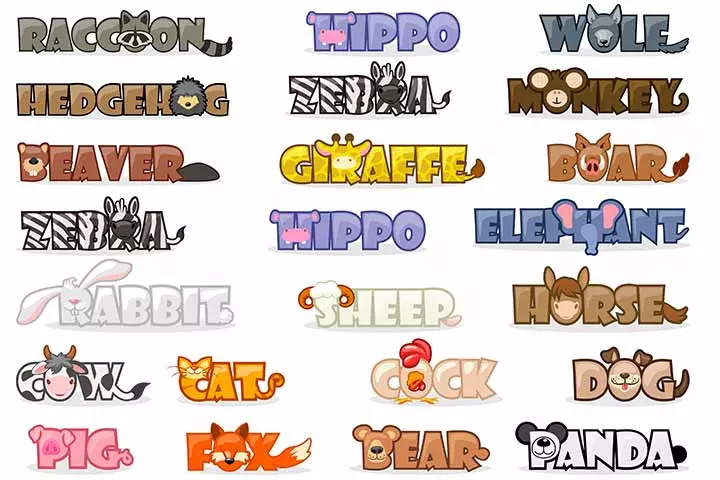
Image: Shutterstock
Name the animal is a multiplayer kids word game that can help teach your children animal names and improve their reasoning skills. This game also offers your child the opportunity to exercise their lateral thinking skills.
Age group: 4 to 7 years
No of players: 2 or more
How to play:
- You can be the host of the game.
- Make a list of common animals and a list of words that rhyme with these animal names.
- Call out each player and present them a rhyming word, and let them guess the animal name. You can say things like, “I rhyme with fog. I am a …..”
- The player who gets the maximum words correct is the winner.
- You can also teach them animal sounds by substituting animal names with their sounds.
3. I spy

Image: Shutterstock
I spy is one of the easiest games of the lot. All you need is your imagination and some eager players.
Age group: 4 to 6 years
No of players: 2 or more
How to play:
- Locate an object, and tell your child its first letter saying, “I Spy an object starting with the letter ….”
- Your child looks around and recognizes each object corresponding to that letter.
- Stop when they get it right and continue the game with the next player.
- You can also mention the color or shape of the object and let your child guess it correctly.
4. Make a word
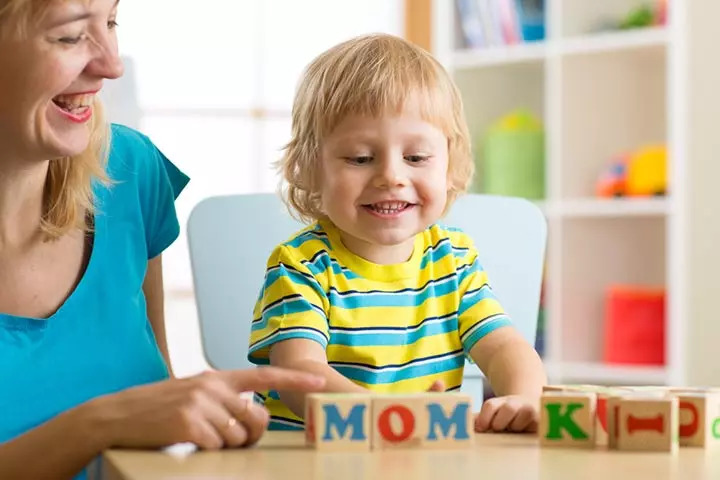
Image: Shutterstock
If your child is starting to learn new words, this word game for kids is useful. You can also play this game with older kids to make them learn difficult words and improve their memory. This game lays a solid foundation for playing advanced spelling games, such as Scrabble.
Age group: 4 to 12 years
No of players: 2 or more
How to play:
- You can play this game with younger children if you have magnetic letters, plastic letters, letter mats, or letter blocks.
- Give them a set of letters and ask them to make two- or three-letter words with them.
- For older children, you can play the game mentally or write a set of letters on a piece of paper and ask them to make as many words as they can from them.
- You can even play a timed version of the game with older children as they enjoy a good challenge.
5. Rhyming words

Image: Shutterstock
Rhyming Words game is a variation of Name the Animal. This word game for kids encourages your child to learn new words and helps hone their reasoning skills.
Age group: For ages 3 to 6 years
No of players: 2 or more
How to play:
- Name any animal.
- Ask your children to say the words that rhyme with the name of the animal, in turns.
- For example, when you say the word “dog,”your children should come up with words such as fog, hog, and log.
- Continue with a player until they run out of words and repeat the game with the next player.
6. Name, place, animal, thing

Image: IStock
You might remember playing this game as a child yourself. This game helps in expanding your child’s knowledge and memory.
Age group: 5 years and above
No of players: 2 or more
How to play:
- Give each player a sheet of paper and a pencil.
- Say a letter of the alphabet and start a timer.
- Each player must write the words of a name, place, animal, or a thing starting with that letter. For example, if the letter is A, a player may write, “Alex, Australia, Ape, Apple,” under each of these categories, respectively.
- You can assign different letters to different players or the same letter to each one.
- You can include other categories as per your convenience.
7. Hink pink
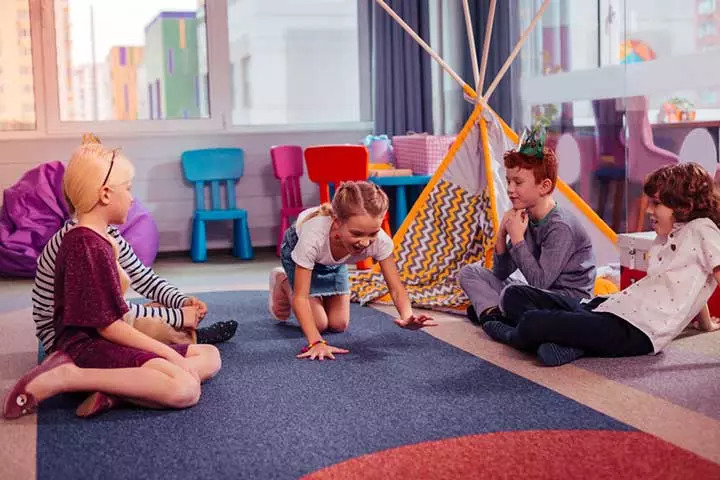
Image: Shutterstock
Children love this game. This word game for kids is designed to maximize fun while learning new words and their meanings. The game can help improve your child’s ability to solve crossword puzzles and cryptic crosswords.
Age group: 4 to 12 years
No of players: 2 or more
How to play:
- Ask each player to come up with a set of rhyming monosyllabic words, e.g., fat rat.
- Help them make a clue about their words. In this case, the clue will be “a rodent that is not thin.”
- Each player says their clue aloud, and the others try to guess what the rhyming words are.
- If the children are older, you can play Hinky Pinky (two-syllable words) or Hinketty Pinketty (three-syllable words). You can even make different combinations between different syllabic words.
- Ask the children to act out the words too so that all of you have lots of fun while the children learn difficult words.
- Here are some more words to get you started: Thin Pin, Big Pig, Tan Pan, Fan Man.
8. Guess the correct word
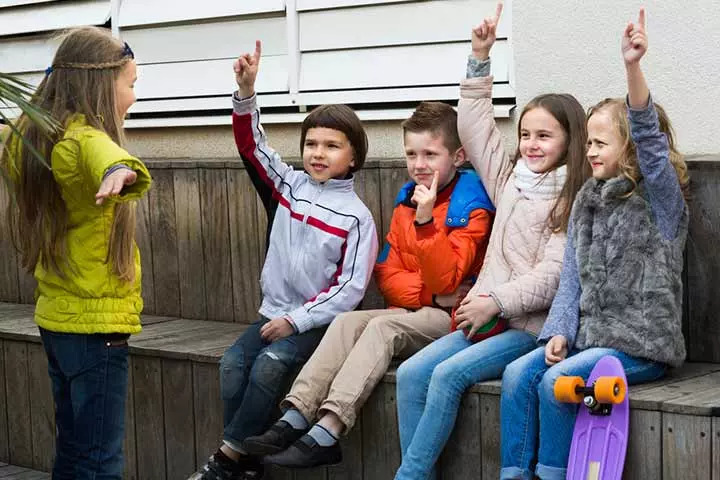
Image: Shutterstock
This word game for kids, if played mentally, is an excellent way to boost your child’s memory. It is a simple game and can be played with pencil and paper if you want to keep score.
Age group: 6 years and above
No of players: 2 or more
How to play:
- The first player thinks of a word and announces its first letter and the number of letters in the word to the others. If the player has thought of the word “Bananas,” they should say B and 6.
- The other players have to guess the word using these clues.
- If a player says another word but it has some matching words with the original word, the first player will say that the word is wrong but there are matching letters in the correct places or the wrong places.
- The next player uses these clues to make the next guess.
- You can keep the words simple or difficult according to the age of the children.
- As for the example of Bananas:
Player 2: Bullock
Player 1: That is incorrect
Player 3: Bahamas
Player 1: That is incorrect, but the As are in the correct place,
and so on.
9. Word hunting
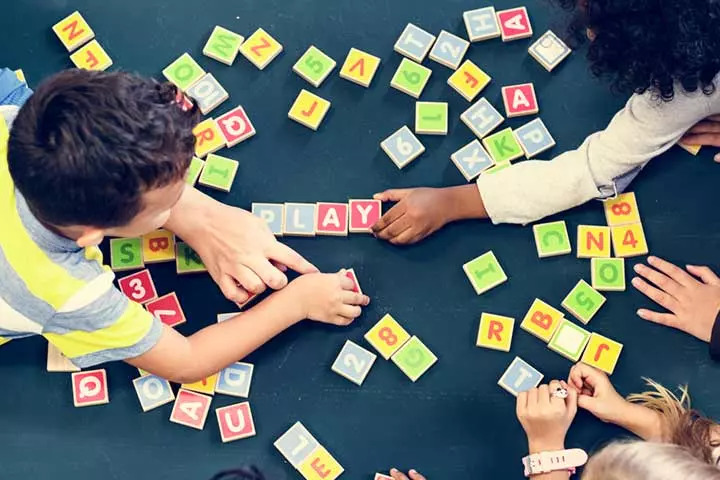
Image: Shutterstock
If your child is just learning the alphabet, this is an easy game to play. However, you can make some minor changes and tweak it for older children.
Age group: 4 to 7 years
No of players: 2 or more
How to play:
- Scatter magnetic letters, plastic letters, or letter blocks on a table.
- Ask your child to pick up a letter from the lot.
- For older children, you can write three- or four-letter words on little chits of paper and do the same procedure as above.
- For children who can read, you can ask them to pick words they see outside shops, etc.
10. Change one letter
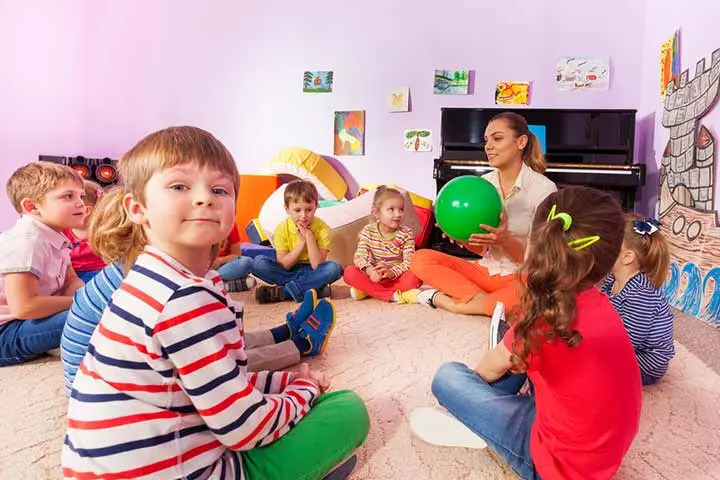
Image: Shutterstock
This is a great word game for school children. The game promotes out-of-the-box thinking and allows your child to come up with new words and even their meanings.
Age group: 5 to 10 years
No of players: 4 or more
How to play:
- Begin with a short word that has three, four, or five letters (according to the age of the children).
- Ask the children to take turns in calling out new words by changing just one letter of the previous word. E.g., park – part – dart – dark / mark – mare – mart / cart – care – case – cast – mast (and so on).
- You can set a timer or divide the players into teams to make the game more exciting.
11. Call my bluff

Image: Shutterstock
Call my bluff is commonly played at sleepovers and during picnics and is an excellent word game for older children.
Age group: 8 years and above
No of players: 4 or more
How to play:
- Divide the children into teams.
- Give them a set of words that are common but unfamiliar to them.
- Ask each team to look up the meaning of each word, and make up two wrong meanings for each word.
- Each team asks the other team the meaning of a word and gives them the three options.
- If the opposite team guesses the correct meaning, they get points. If they don’t, the team that asked the meaning gets the point.
- For example, let us take the word “Bewildered.” You can give three choices (a) to be left in the wild, (b) shocked or surprised, and (c) out-of-control behavior.
12. Unscramble the words
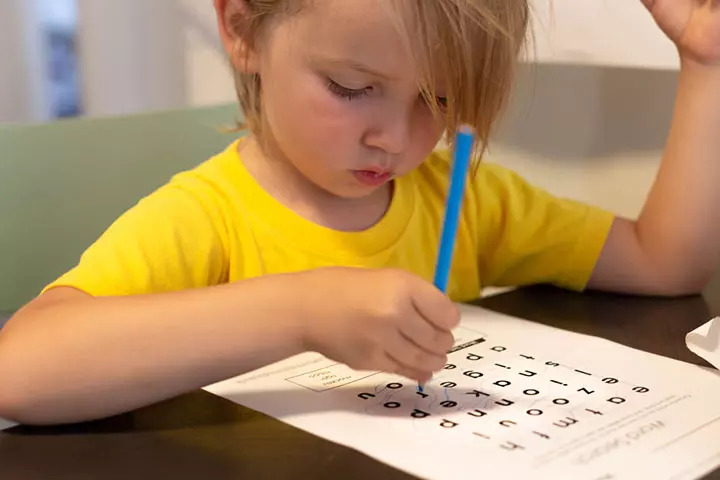
Image: Shutterstock
Let your children put on their thinking caps and play this game. The word game makes your child think and helps stir their imagination and improve their reasoning skills.
Age group: 5 years and above
No of players: 2 or more
How to play:
- Think of a word and write it down on paper but in a scrambled form.
- Your child has to think and arrange the word in the right sequence.
- You could even give clues so that they can unscramble the word faster.
- You could also write down a set of scrambled words, set the timer, and ask them to solve as many as they can within the allotted time.
13. Tell me a story

Image: Shutterstock
Children are incredibly imaginative. Children, as young as three years old, start making imaginary stories. You can play this game to fire your child’s imagination.
Age group: 5 years and above
No of players: 2 or more
How to play:
- Start a “story” with a sentence.
- The next player should say another sentence and continue the story.
- As the story grows, it becomes hilarious and absurd.
- For example, you start with the sentence, “In a village, there was a man named Joe.” The next player can say, “He wore a red shirt every day,” and the next player may say, “One day, a bull charged at him,” and so on.
14. Words in a word
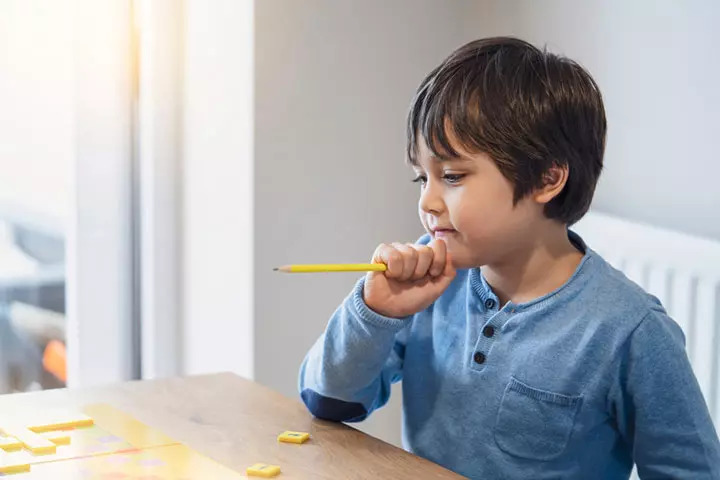
Image: Shutterstock
This is one of the most popular word games for kids and one of the best word-building games of all time. It is useful in improving your child’s English, if it is not your native language. You might have played this game in your childhood. It is now your children’s turn to play the game and keep the tradition alive.
Age group: 5 years and above
No of players: 2 or more
How to play:
- Think of a long word. A popular word choice for this game is “Constantinople.”
- Ask your child to write words starting with each letter in the word. They should use the letters contained in the word only.
- For example, Constantinople can have words such as con, cot, on, oil, no, nap, sit, and sip.
- You can set a timer and ask your child to write down as many words as they can within the given time frame.
15. I’m going on a picnic

Image: Shutterstock
This game is for older children. It helps hone their creative skills and improves their memory. The word game is usually played in classrooms, but they can play it at a sleepover or even with you as a family game.
Age group: 5 years and above
No of players: 3 or more
How to play:
- The first player starts by saying, “I’m going on a picnic, and I will bring a ….”.
- The next player adds an item to the list and repeats the words.
- Each player has to repeat the items named in the exact sequence.
- If a player forgets a name or the sequence, they are out of the game.
- You can either start the game all over again or ask the next player to pick up the sequence and continue.
- For example, the game goes as follows:
Player 1: I’m going on a picnic, and I will bring a cookie.
Player 2: I’m going on a picnic, and I will bring a cookie and a Popsicle.
Player 3: I’m going on a picnic, and I will bring a cookie and a Popsicle and a bottle of juice, and so on.
16. Crosswords
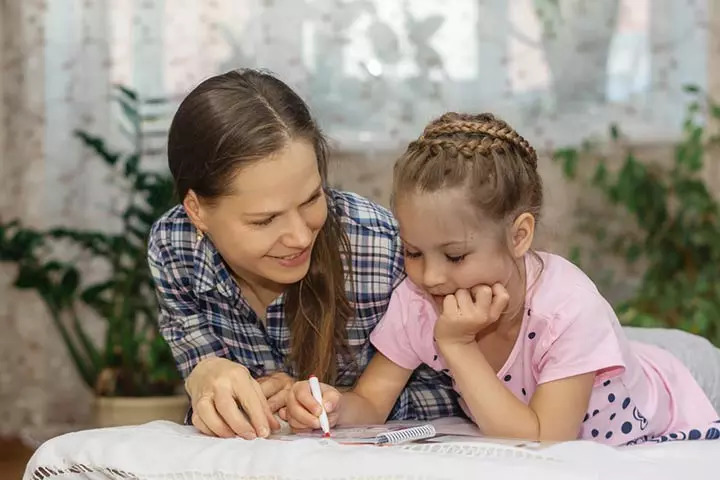
Image: Shutterstock
Solving crosswords requires practice and a lot of patience. The game will not only teach your children new words but also develop their deductive reasoning skills to a great degree.
Age group: 6 years and above
No of players: 1
How to play:
- Draw a grid with white and black squares and number each row and column.
- Then, write a set of clues at the bottom of the grid with the corresponding row or column number.
- Ask your child to solve the crossword.
- You can set a timer to make the game challenging.
- You can get some printable crosswords with clues easily on the Internet (you will find some free and printable crosswords in this link). Crosswords regularly appear in newspapers and magazines.
17. Word quest
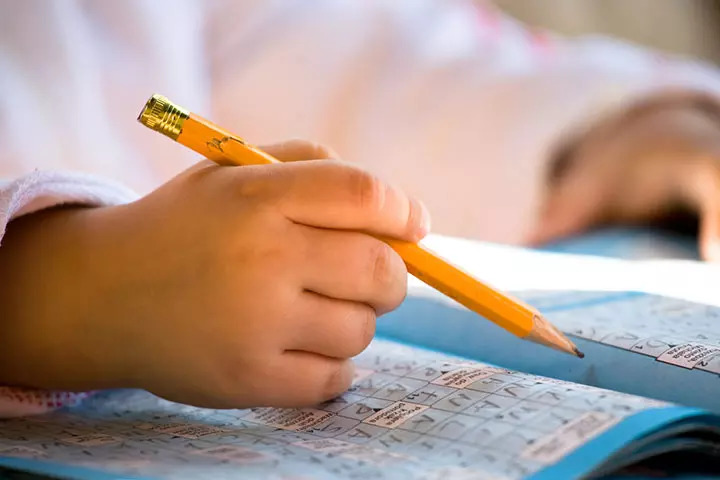
Image: IStock
Word quest is a word game for older kids. The game involves searching for words using single letters and makes your children use their deduction skills.
Age group: 5 years and above
No of players: 2 or more
How to play:
- Draw a 10×10 or 12×12 grid on a sheet of paper and divide it into squares.
- Write various words below and to the side of the grid.
- Write random letters in random squares.
- Ask your child to fill in the grid using the words you have written outside the grid.
18. Consequences

Image: Shutterstock
This word game helps stir the imagination and encourages creativity. The game works well with both children and adults.
Age group: 5 years and above
No of players: 2 or more
How to play:
- The first player writes down a sentence on a sheet of paper and passes it on to the next player.
- The next player writes the next sentence and passes it on.
- Once all the players are done with adding their sentences, you can read out the story.
- You can also write 4–5 sentences with open endings on a sheet of paper and hand them over to each player. Each player writes their version of the story and reads it aloud at the end of the game.
- For example, you can write, “There was a man named …….. He …………. a woman named ……………. They went to …………. He said, “…………………” She said, “……………………” And then, ……………..” and so on.
19. Scrabble
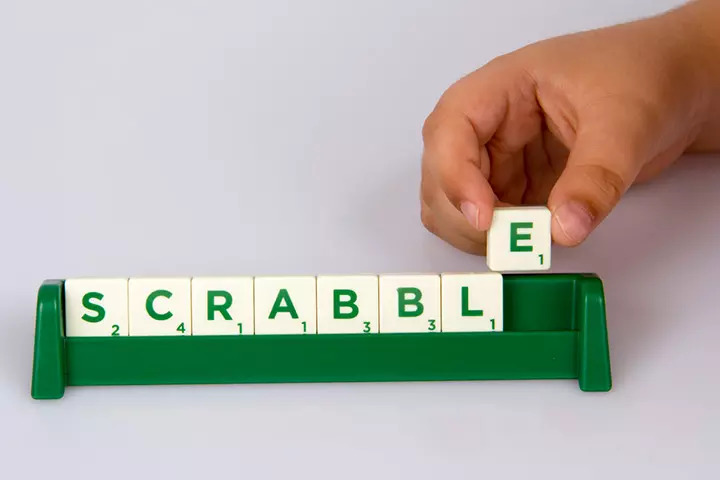
Image: IStock
Scrabble is a popular classic word game for kids. If you want your child to learn new words, this is one of the best games.
Age group: 6 years and above
No of players: 2 or more
How to play:
- Get a scrabble boards.
- Set it up and read the rules.
- The number on each letter tile tells you how many points it’s worth, and the squares on the board tell you how many points you scored.
- The player who gets the maximum score is the winner.
- After a game of Scrabble gets over, the board looks similar to a crossword.
20. Pass the bomb
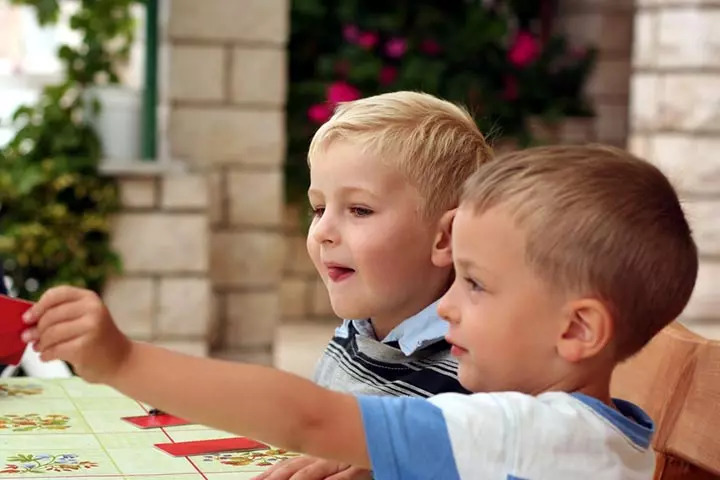
Image: Shutterstock
Pass the bomb is an educational game that will test your child’s alacrity. The first player should say a word and pass the bomb as quickly as possible to the next player, who must say a similar-sounding word. The players need to be quick in passing the bomb before it explodes. You can get this board game at a shop or simply make your own set.
Age group: 5 years and above
No of players: 2 or more
How to play:
- Take a set of card papers and write two- and three-letter words on them with a marker.
- The first player picks up a card and passes it around.
- The “bomb” goes off after a certain time. If you have made the cards at home, you can use a timer or even play music.
- The moment the timer goes off (or the music stops), the player holding the card is out.
- However, before leaving, they have to say a word that contains the word written on the card.
- For example, if the card has “ART” written on it, the child who gets out can say a word with ART in it, such as part, mart, or cart.
1. How can word games help children improve their spelling skills?
When children engage in word games, they are required to focus on the spelling of various words, which helps them to learn and remember the correct spelling of those words.
2. In what ways can word games help children with their grammar?
Word games encourage children to think about language playfully and engagingly, making it easier to understand and remember grammar rules. Word games can also help expand children’s vocabulary, an essential component of good grammar. By learning new words and their meanings, children can improve their ability to express themselves clearly and accurately.
3. How can word games help children improve their vocabulary?
Word games are an excellent way to improve children’s vocabulary skills, as they help them learn new words and reinforce their understanding of familiar ones. Games such as Scrabble, Boggle, and crossword puzzles challenge children to think critically and creatively about words, requiring them to use problem-solving skills to develop new words and find hidden ones.
4. How can word games help children become better readers?
Word games can help children become better readers by improving their vocabulary, spelling, and comprehension skills. Such games require children to identify and create words, helping them to recognize new words and understand their meanings. This eventually improves their reading skills.
When education is imparted as activities and games, children tend to grasp it much faster and retain it longer. So, if you want your children to have great communication skills, fluent vocabulary, and fascinating imagination, involve them in word games for kids. Games, such as I spy, make a word, or hink pink, are effective in keeping children engaged and sharpening their grammar and vocabulary. Another good thing about these games is that you can be involved in playing too. So, choose a suitable word game according to your child’s age and have fun while playing.
Key Pointers
- Word games stimulate the brain to improve reasoning skills, vocabulary, and language skills.
- Spur creativity through games such as I spy, rhyming words, and hink pink.
- Test the memory with games such as guess the correct word and make a word.
Was this article helpful?
The following two tabs change content below.
- Reviewer
- Author
Everyone should know how to play pen and paper games! They make great icebreakers, waiting games, quick boredom busters, and fun activities for gatherings with friends or family.
And best of all? All your need is a pen or pencil and paper to play!
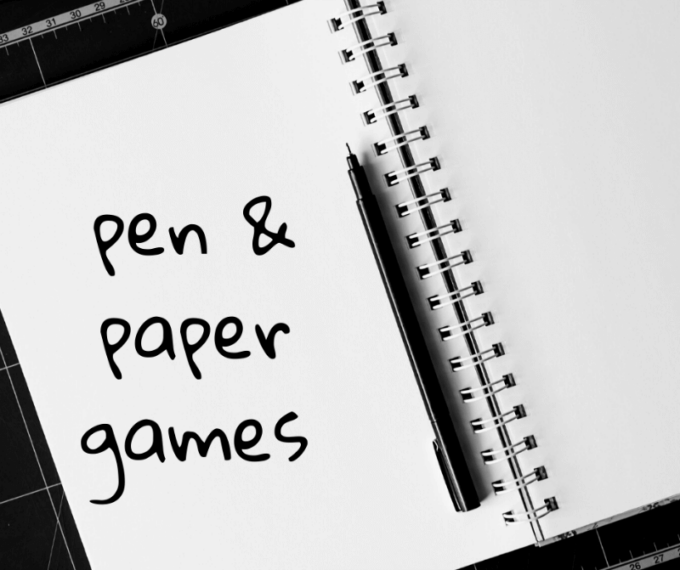
Fun pen and paper games come in several types. There are drawing games for one or more players, two player games of strategy and logic, of which the most well-known is tic-tac-toe (a.k.a. noughts and crosses), and paper games that can be played with two or more players. So whatever situation you find yourself it, there is a pen and paper game for every occasion!
Single Player Pen and Paper Games
Most of these pen or pencil and paper games are suitable for more than one player as well! Children can collaborate on the activity with another person, or they can play them side by side.
Blind Drawing. Grab a pencil and paper, take a look around you and pick one object. Close your eyes and try to draw it without picking up your pencil!
Word Flip. Click here to read the full instructions for the funny flips game. This is a fun pen and paper game to practice grammar skills and make you laugh. When you’re done, pass the game off to another person if possible and have them put together sentences with your creation.
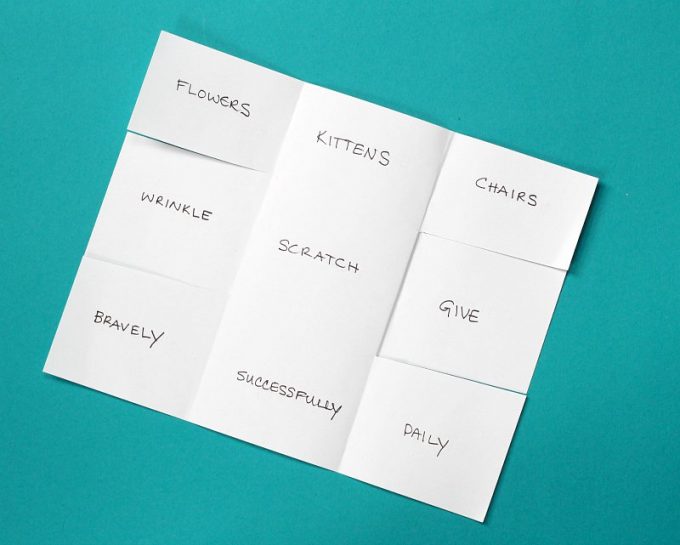
Drawing Game. Based on the game exquisite corpse, this is a flip picture game. While it can be played by just one person, getting another artist into the action to alternate drawing the body parts will increase the fun. Watch the video below to see how it is done.
Two Players
These pen and paper games require two players. Some of the games require that players have pens of different colors.
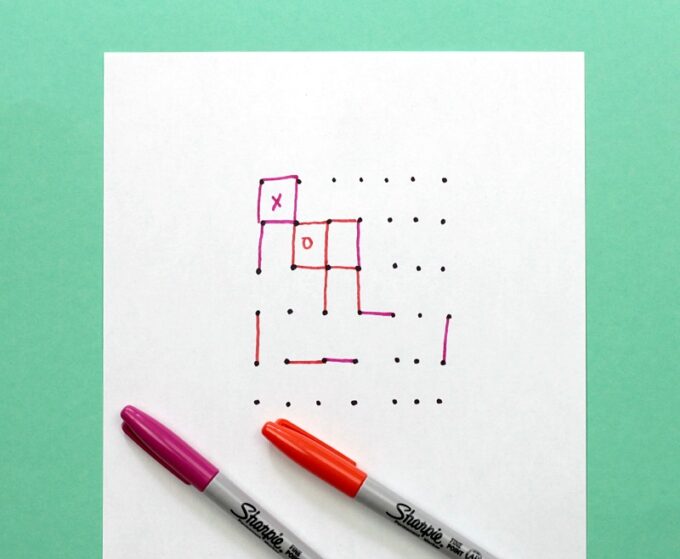
Dots and Boxes. You can’t go wrong with this classic pencil and paper game! You can use graph paper, but it’s not necessary; simply plot out dots in an array. Watch the video below to see how to play!
Hangman. This game needs no explanation, but I’ll give it to you anyway. One person thinks of a word and draws dashes along a paper to represent each letter in the word. Above the dashes he draws platform and stand. The other person guesses one letter at a time. If the letter is in the word, the first person fills in the blank(s). If not, the incorrect letter is written below and the first person draws one body part at a time. If the person guesses the word before the body is completed (head, torso, 2 arms, 2 legs), he wins, if not — well, he loses.
Apple Tree. This is a less-macabre version of the old favorite, Hangman. One person thinks of a word and draws dashes along a paper to represent each letter in the word. Above the dashes he draws a tree with 7 apples. The other person guesses one letter at a time. If the letter is in the word, the first person fills in the blank(s). If not, the incorrect letter is written inside one of the apples. If the person guesses the word before all the apples are filled, he wins, if not — well, he loses.
MORE: 8 Variations on Tic-Tac-Toe
Bridges. Begin by drawing an abstract shape and dividing it into sections, 30-50 sections is ideal. (see photo below) Taking turns and using different colors, players build bridges by starting in one section, crossing a second, and ending in a third section. Players may not start, cross or end in a section that has previously been used. Players alternate building bridges until no bridges can no longer be built. The last player to build a bridge wins.
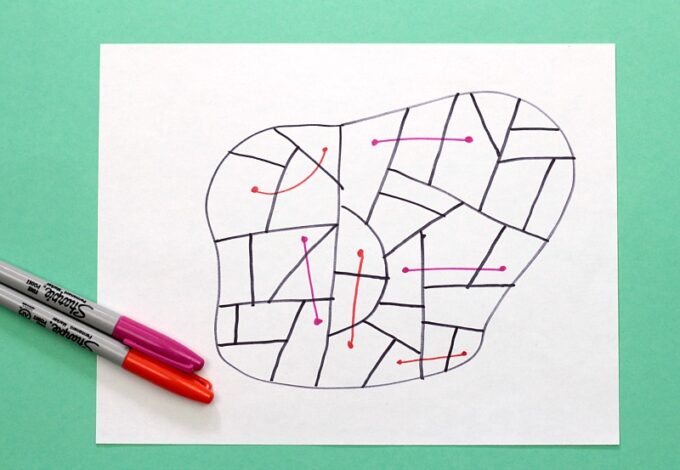
Nim. Nim is a very old game that is usually played with stones or tokens. But it’s also a game that can be played with pen and paper. Draw 1, 3, 5, and 7 marks in the shape of a pyramid as shown in the illustration. The objective is to force your opponent to cross out the last remaining mark. Players alternate turns crossing out as many marks as they wish on each turn. However, they can only cross out marks on one line per turn.
I have a variation of a Nim subtraction-type game here, or watch the video below:
Sim. Click here to read the full Sim instructions. Draw six dots as the vertices of a hexagon. Players alternate drawing lines from dot to dot in their own color. The first person who is forced to draw a triangle formed from their own color and three of the vertices loses.
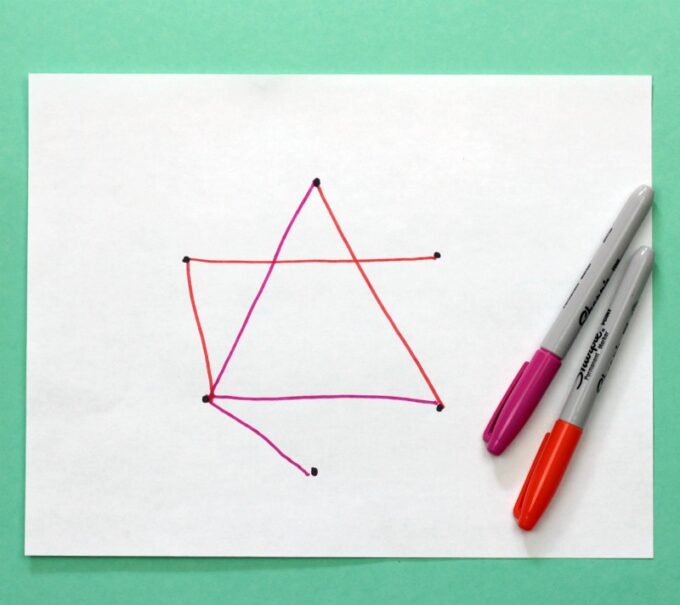
Lasso. Draw a grid of dots on paper, as many or as few as you want. You can experiment to see how many dots you prefer. Taking turns players start at one dot, draw a line to any other dot and circle it. Lines must stay within the confines of the grid. You may only circle a dot that has not yet been used and your line may not bisect any other line. You may start on a dot that has already been used as a starting point. When there are no available moves left, the last person to draw a lasso wins.
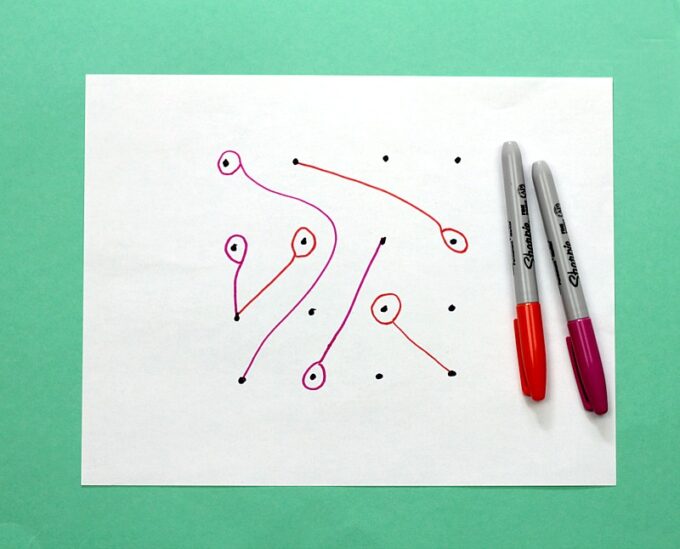
Tandem Drawing. This is a very enjoyable, low-stress way to connect with your child. Watch the video to see how it’s done!
Two or More Players
These pen and paper games work well when you have more than two players. Potentially, you could try playing Bridges and Lasso (see above) as three person games.
Unscramble. Write a list of 10 words, but instead of spelling them correctly, mix up the letters and challenge your opponent(s) to unscramble them. To make it a little more fun, select all words from a single category. For example: kcae, kieooc, epi, ssertde, eci mreac become cake, cookie, pie, dessert, ice cream. The first player to unscramble all the words wins.
Words Within A Word. Write out a long word on a piece of paper or a white board if you have one. Set a timer for 3-5 minutes and everyone tries to find as many smaller words as they can using only the letters in the designated word. (See photo below for an example.)
What pen and paper games will you play today?
More games here:
- 20 screen-free waiting games
- Memory games — no screens necessary!
- 15 word games
- Screen-free road trip games for kids and families
- 15 brain games
16 easy whiteboard games
A simple list of games for English classes that you can do on a whiteboard. These are always handy to call on if you have limited facilities or resources available. You only need your board, markers, pens and paper.
Some games require a little bit of preparation while others need none at all. The whiteboard games are not only fun but also educational.
1 -Tic-Tac-Toe
This game is also known as noughts and crosses. Divide your class into 2 teams, team X and Team O. After drawing a 3 by 3 grid, you get students to take turns choosing a square in which they put their team’s marker – X or O. They need to get 3 in a row horizontally, vertically, or diagonally to win.
To make this educational write or draw a target word that they are learning in each box. When a student chooses the box they must say the word or use it in a sentence. Having done that you can write their X or O in the square and move to the next team’s turn.
2- Pictionary
This is one of the simplest whiteboard games but it creates a lot of laughter! To play firstly divide your class into small teams. Next, get one person in the class to come to the board and give them a marker and a word. Their objective is to draw the word in order for the class to guess what it is. Finally, give a point to the team that guesses the word first. You can find further instructions on the free pictionary cards page.
3 – Hangman
You are usually scraping the bottom of the barrel if you are down to hangman and it is so well known there is no need for instructions on this page. That being said it is still fun for students. A good variation for younger students is to draw a set of steps with a monster or shark at the bottom. A circle or shape at the top of the stairs for each team. If they choose a letter that isn’t in the word they move down one step. Too many incorrect guesses and the monster eats them!
4 – Missing Object/Text
To play this game get 2 to 5 students to stand at the front of the class. Write a series of words on the board such as – tiger – elephant – fox – eagle – frog – camel – bear. Next, ask them to turn around. Once they are facing away from the board, erase one of the words. When you say “go” the students must turn around and name the missing word. The first student to say the missing word earns a point for their team.
5 – Scrambled Words
This is one of the best whiteboard games to review vocabulary your class has been learning. Select a list of words you want to go over and write them on the board with the letters jumbled up. It also a good idea to write numbers next to them. You might for example write 1- nwwoid for window, and 2- rmooslacs for classroom. Award points to whichever team solves a word first.
A variation of this activity is to use anagrams, actual words that contain the same letters like star and rats, or tacos and coats. See if your class can find anagrams of the words you write on the board. You will have to spend some time to compile a suitable list before doing this.
6 – Mixed-Up Sentences
Mixed–up or scrambled sentences can be used for primary, high school and adult lessons. You just need some sentences with the words in the wrong order. A simple example might be – cat black small is the = The black cat is small.
You can print out some scrambled sentences here and get your students to write the correctly worded sentences on the board in a team race.
If you don’t have a printer, you can write your scrambled sentences at the top of the board or even dictate them.
7 – Boggle
Boggle is a fun word building game that almost everyone knows. To play it simply draw a 4 by 4 grid on your board and put 1 letter in each box. Students need to make words by using adjoining letters. There is a thorough description and some grids you can use on the free printable boggle word puzzles page.
8 – Stop the Bus
This game has a few different names but the most common I’ve heard is stop the bus. It is very similar to the board game Scattegories if you have ever played that.
Divide your class into pairs or small groups. Each team will need a piece of paper and a pen. On the board write a list of categories, 6 or 7 is a good number. Let’s say your categories are – Animals, Clothing, Countries, Jobs, Sports, and Fruits. Next, write 1 letter on the board and shout “go!”. The students must write down one word for each category that begins with the letter you provided. The first team to complete the list yells stop the bus which means everybody else should also stop writing.
If the letter was G, the answers could be Animals = Gorilla, Clothing = Gloves, Countries = Germany, Jobs = Gardener, Sports = Golf, and Fruits = Grapes. Points are given to each team for each correct answer. You can also play this game with a timer of say 2-3 minutes and let all teams think of answers until time’s up.
9 – Word Association
Word association is a simple yet enjoyable brainstorming activity. Start with any one word and then ask a student to think of a word related to it and write it next to your original word. The next student must think of an associated word for the previous student’s answer.
Let’s say you start with the word water, an example might be like this –
Water – swim – sport – tired – bed – night – star – moon, and so on.
10 – Rebus puzzles
Rebus puzzles are great brainteasers that all ages enjoy. Divide your class into teams and draw 10 or more easy puzzles on the board. The first team to guess one of the rebus meanings gets a point. There are plenty of examples for you to copy on the free printable rebus puzzles page!
11- Jeopardy
Play a quiz game on the whiteboard just like the TV show! You will need to prepare a list of five questions for each of your categories but it doesn’t take long. The key is to make the questions increasing difficult with the first question being the easiest and the fifth question being quite hard.
Once you have questions, all you need to do is draw a grid on the board. Across the top write the categories and on the left column write the value of the questions in points or money. This game works best in teams but make sure that individual students in teams take turns to choose and answer questions.
12 – Bomb Games
If you’ve ever used any PowerPoint bomb games, you know they are a hit! You can easily replicate them as whiteboard games by drawing a grid and numbering the boxes or by using the alphabet. Again you will need some pre-prepared questions, any topic or difficulty can be used. You also need to draw a key beforehand and decide where the bombs and rewards will be placed.
To make your key, write down the letters or numbers you will use on your grid. Next to each number put a number of points, a bomb or something else to be awarded for that square. You might have a flower which could be +3 points, a rainbow +7, some dynamite -3, a big bomb -5, a gun (take 3 points from another team, a bird (switch points with another team). You can use whatever you like!
Once everything is ready, ask a student or a team a question. If they answer correctly, they get to choose a square on the board. With your key in hand, you erase the square’s number and write or draw what is on your key. Finally, award the points or whatever it may be to the team.
13 – Family Feud
Family Feud seems to be the most popular of all the whiteboard games. It is based on the TV game show from America. It does take a little preparation but it is totally worth it as all classes love it.
You need to prepare some lists of 5 to 10 words in categories. For example, if your category is zoo animals you might have a list of monkey, crocodile, zebra, lion, hippo, tiger, giraffe, and panda. Do not show the class the list.
Divide your class into pairs or small groups and write – 8 Zoo Animals on the board. Next, Students must write down 8 animals on a piece of paper with a time limit of only a few minutes. Once time is up, you write your 8 animals on the board. For each word that a team wrote, they get a point. Play the game over several rounds and tally up the winner at the end. For a more in-depth article with printable questions and answers, check out the Family Feud for the classroom page.
14 – Hot Seat
Hot seat is a very easy game that can get quite raucous. Place a chair in front of the whiteboard facing away from it so whoever sits in the chair can’t see the board. Get a student to come and sit in the chair. Behind the student write a word on the board. The rest of the class must describe the word without actually saying it. The student in the hot seat chair must listen and guess the word. Once they answer correctly, get them to choose another student to replace them in the chair.
This game also works really well with 2 or 3 chairs, where the first person to guess the word wins. You may need to mention that spelling and body language is not allowed.
15 – Taboo
Taboo is just like hot seat above but you add a few extra words that cannot be said (taboo words). For example, if the word to be guessed is – monkey, your taboo words might be banana and tree. It makes the activity much more challenging and useful for advanced classes. For printable cards for this game to use as ideas check out the Taboo ESL game page.
16 – Word Wheels
These vocabulary puzzles are great for English learners and are very easy to draw on a whiteboard. With your class in teams, award a point for each word a team creates. You can also give higher scores for longer words. You can also set your teams a time limit and let them write their answers on paper.
Check out the ESL vault free word wheel puzzles printables for more detailed instructions and puzzles with answers you can use. The puzzles were designed as worksheets but can be used just effectively as whiteboard games for kids or adults
You might also like these
Mastering spelling, learning sight words and developing other literacy skills is a big job for kids in the early years at school. You might find you are just as daunted as they are by the big list of words they bring home, and you might be thinking – where do we start?!
It’s amazing how many kids just glaze over once they see lists of words on paper, or when you place a pencil in their hand. They seem to get the idea early on that this is what ‘work’ looks like, and usually ‘work’ means playtime is over. The result may be anything from passive resistance to flat out rage. Well that’s about to change!
These FREE printables have been created especially for Be a Fun Mum readers, and are word games that aim to help make learning literacy skills more fun. Print out the instructions and accompanying sheets, and follow the directions. It’s that easy!
Nicole from Gateway Therapies
1. Sight Word Detective
See how many words you can spy on the game sheet. Some are hiding in tricky places. How many words can you find before time runs out? All words will score a point, but sight words get bonus points!
2. A Quick Word
How many different things can you think of that start with the same letter? You have a list of ten things to think of an answer for, and you have to think quickly. Time is ticking.
3. Picture This
Put pen to paper and get drawing! This is a game of fast drawing and good guessing. Put those motor and visual processing skills to the test. Fun for all ages.
The instructions include bonus tips on how each activity can be modified or extended to incorporate other skill areas important for learning such as visual processing, fine motor skills including handwriting, attention and concentration, and auditory processing.
Multi-sensory learning can be incorporated by:
- Using coloured and/ or textured paper for the printables
- Writing using a variety of pens and other media
- Change the environment in which you are playing the games. Throw a picnicrug outside and sit in the yard, or stand around the kitchen bench while munching on afternoon tea.
Age suggestions accompany each activity, however you know your child best. Use these suggestions as a rough guide. Below is a snapshot of the 29 page printable which you can access by clicking the picture below or clicking here.
About Nicole Grant
Nicole is a privately practicing Occupational Therapist (OT) in Brisbane, Queensland and mother to 2 beautiful girls.






